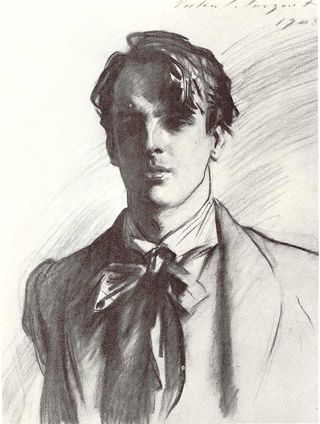On the Irish Nobel winner's place in the literary movement

In a review of Calvin Bedient's new book,
The Yeats Brothers and Modernism’s Love of Motion, Robert Huddleston takes a look at the significance of William Butler Yeats in relation to twentieth century modernism (via the wonderful
3quarksdaily):
William Butler Yeats has been called the twentieth century’s greatest poet. He may even deserve the title. As Richard Ellmann wrote in his classic study Yeats: The Man and the Masks, “it is not easy to assign him a lower place.” Others may have attempted more; none achieved it. Ezra Pound, T. S. Eliot, Wallace Stevens, and all the other contenders of Yeats’s illustrious generation—none stakes quite the same claim on the imagination, or on the idiom, of our time. “Things fall apart; the centre cannot hold”; “A terrible beauty is born”; “Now days are dragon-ridden, the nightmare / Rides upon sleep.” Even Joyce has his protagonist Stephen Dedalus murmuring lines from Yeats’s early poem “Who Goes with Fergus?” on Sandymount strand: “And no more turn aside and brood / Upon love’s bitter mystery.” Like Shakespeare, Yeats is inescapable.
Yet few critics, including Ellmann, have seemed entirely comfortable with this fact. As a man, Yeats could be personally unappealing, even arrogant and intolerant, although not more so than Eliot and less so than Pound. The problem with casting Yeats as the ne plus ultra of twentieth-century poets stems from the fact that his work defies preconceptions about what a sufficiently modern—and specifically Modernist—poetry should be. Yeats’s ties to the nineteenth century and the legacy of Romanticism were vital and strong. Most importantly, Yeats forsook radical formal innovation and was instead a lifelong advocate of traditional poetic meter and form. [Read More]
 In a review of Calvin Bedient's new book, The Yeats Brothers and Modernism’s Love of Motion, Robert Huddleston takes a look at the significance of William Butler Yeats in relation to twentieth century modernism (via the wonderful 3quarksdaily):
In a review of Calvin Bedient's new book, The Yeats Brothers and Modernism’s Love of Motion, Robert Huddleston takes a look at the significance of William Butler Yeats in relation to twentieth century modernism (via the wonderful 3quarksdaily):

